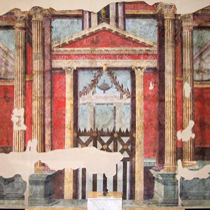 1>
1>Picard’s false-door Revisited
On the wall adjacent to the door motif that prompted Picard to speculate on the symbolic use of door images in Roman wall-painting, is another painting that supports his theory that they represented entrances to metaphysical worlds. The painting is currently housed in the Musée Mariemont in Belgium (fig.1). The composition is typical of the gated type and depicts a deity in a tholos sanctuary that is protected by apotropaic masks. Its presence not only reinforces Picard’s ‘false-door’ theory, but also suggests that in this triclinium commemorative meals were held in honour of both the gods and heroized ancestors. The crown of Zeus, which is being lifted skyward by a winged figure seen floating above the hunting frieze on Picard's false-door, may well suggest that the sanctuary beyond this door is not only protected by Zeus, but is also a place in which apotheosis has taken place (fig.2).
One of the few paintings to visualise a deity emerging from a half open door was found deep inside the Casa di M Fabio Rufo. The goddess is thought to be Venus the cult divinity of Pompeii. For reasons discussed earlier, the painting was over painted and a candelabrum replaced her image (fig.3).
Four entrance motifs found in a single room on the Palatine Hill in Rome, openly display vistas leading to sanctuaries (fig.4). They are in a house thought to have been owned by Augustus and the numerous Apollonian references to swans, griffins and a quiver reinforces this theory. Augustus cited Apollo as his talismanic divinity and in gratitude for his victory over the forces of Mark Antony and Cleopatra, he dedicated a temple to Apollo adjacent to his Palatine house in Rome. It is also, therefore, very likely that at the centre of his personal empire, his house, he may have dedicated this room as a sacrarium to Apollo, thus venerating him whilst also surrounding himself with sanctuaries dedicated to his protector divinity, and possibly also to the memory of his ancestors.
An even more mysterious depiction of a divinity appears in a wall-painting in Room H of Villa Boscoreale. In many ways this painting acts as a metaphor for all the false-door wall-paintings in so much as it both hides and reveals the presence of divinity. The entire room is made up of large figurative paintings that included the three graces and other yet unidentified figures, many of whom pointedly stare back into the room (fig.5). On the right of the right lateral wall is an actual door and to the left of the door is a depiction of a woman holding a highly polished shield in which is reflected the image of a naked man (fig.6). In Roman Wall-Paintings from Boscoreale in the Metropolitan Museum of Art, Phyllis Lehmann outlined her theory that room H was dedicated to Adonis and as such was used for his ritual worship and commemoration. In which case the reflection in the shield could well be his returning spectral image, thus making the configuration of figure, shield and door highly poignant, with the door performing both a real and symbolic function.
|